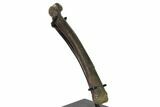This Specimen has been sold.
6.7" Fossil Raptor (Saurornitholestes?) Femur on Metal Stand - Montana
This is a gorgeous, 6.7" long fossil raptor (Saurornitholestes langstoni) femur from the right leg, collected from the Two Medicine Formation this summer. The majority of the cortical bone on this specimen is still present, though both the proximal and distal ends of this bone have undergone some weathering. There are six repaired cracks through the diaphysis, two of which required more gap fill restoration than the others. There is a repaired crack through the proximal epiphysis that also required some gap fill restoration.
This specimen comes with the pictured custom metal display stand.
While typically these raptor bones can be difficult to accurately provide a species for, this specimen has distinguishing characteristics that indicate that it is in fact a femur from Saurornitholestes. The proximal and distal ends of this bone are at the adult stage of their development, which eliminates the possibility of this being a large juvenile raptor femur. The girth and profile of the bone also indicates that it isn't from Bambirapor or Dromaeosaurus, leaving us with Saurornitholestes.
Theropods from the Two Medicine Formation were quite abundant, especially the relatively small species. The largest of these theropods were the tyrannosaurids Daspletosaurus torosus and Gorgosaurus libratus. Where dromaeosaurids are concerned, Bambiraptor feinbergorum, Dromaeosaurus albertensis and Saurornitholestes langstoni species have been identified from this location.
This specimen comes with the pictured custom metal display stand.
While typically these raptor bones can be difficult to accurately provide a species for, this specimen has distinguishing characteristics that indicate that it is in fact a femur from Saurornitholestes. The proximal and distal ends of this bone are at the adult stage of their development, which eliminates the possibility of this being a large juvenile raptor femur. The girth and profile of the bone also indicates that it isn't from Bambirapor or Dromaeosaurus, leaving us with Saurornitholestes.
Theropods from the Two Medicine Formation were quite abundant, especially the relatively small species. The largest of these theropods were the tyrannosaurids Daspletosaurus torosus and Gorgosaurus libratus. Where dromaeosaurids are concerned, Bambiraptor feinbergorum, Dromaeosaurus albertensis and Saurornitholestes langstoni species have been identified from this location.
About The Two Medicine Formation
The Two Medicine Formation is a geographical formation in Central Montana and Southern Alberta, Canada. The formation is predominantly sandstone laid down by rivers and deltas during the Campanian Age of the Cretaceous, about 80-75 million years ago. Approximately two thousand feet thick on the western edge, it lies on top of the Virgelle Sandstone formation and under the Bearpaw Shale. It is located between the Front Range of the Rocky Mountains and the Sweetgrass Arch, a tectonic fold feature 40-90 miles east of the Front Range.
The Two Medicine is the same age as the Judith River Formation found further east. It was laid down further inland from the Western Interior Seaway, while the Judith River Formation was deposited along the coast. The Two Medicine contains much of the same dinosaur fauna, but fewer reptiles, amphibians, and aquatic fossils.
The Two Medicine Formation is a geographical formation in Central Montana and Southern Alberta, Canada. The formation is predominantly sandstone laid down by rivers and deltas during the Campanian Age of the Cretaceous, about 80-75 million years ago. Approximately two thousand feet thick on the western edge, it lies on top of the Virgelle Sandstone formation and under the Bearpaw Shale. It is located between the Front Range of the Rocky Mountains and the Sweetgrass Arch, a tectonic fold feature 40-90 miles east of the Front Range.
The Two Medicine is the same age as the Judith River Formation found further east. It was laid down further inland from the Western Interior Seaway, while the Judith River Formation was deposited along the coast. The Two Medicine contains much of the same dinosaur fauna, but fewer reptiles, amphibians, and aquatic fossils.
SPECIES
Saurornitholestes?
LOCATION
Pondera County, Montana
FORMATION
Two Medicine Formation
SIZE
6.7" long femur. 5.9" tall on stand
CATEGORY
SUB CATEGORY
ITEM
#165905
We guarantee the authenticity of all of our specimens.
 Reviews
Reviews















